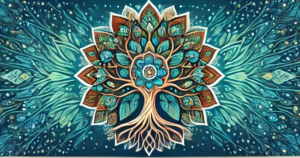The Sacred Gift of Struggle
The Concept of “Dukkha” or Suffering
The Buddha taught us many beautiful things, most notably around the concept of “suffering.” This suffering – termed “dukkha” can take three forms – 1.) the suffering that comes along with the process of “life” itself (sickness, injury, old age), 2.) the suffering that comes with change and impermanence (losing the things we hold dear in life), and 3.) the suffering that comes existentially through the process of being human.
The Buddha taught that these forms of suffering are a result of the attachments and desires we hold in our minds. Often referred to as “cravings,” these attachments come in subtly disguised through stories we craft for ourselves regarding what we “need” in life or stories around how life should look.
Thus, the way to end “suffering,” according to the Buddha, is to end attachment to our stories of need and “should-be’s.” This process is outlined in the Noble Eight-Fold Path. In this practice, one is encouraged to cultivate a state of happiness – or joy – that is not dependent on outside circumstances or life events, but rather a constant state within the heart.
The Nature of Being Human
Who am I to argue with the Buddha? In truth, I am not. However, this Buddhist teaching – at least as it is often currently presented in our modern society – skips over an important element of human growth and development. Omission of this critical step leads to stunted emotional and spiritual growth.
We are designed as beings that exist in constant states of expansion and contraction. At night we “contract;” we sleep in order to digest, to heal, and grow. During the day, we enter a state of expansion or “doing.” This is only one of many such expansion/contraction cycles, not only within the human form, but within the state of all life itself; all animals sleep and even plants enter states of cyclical dormancy.
As the nature of all “BEing” is fractal, we see this same expansion/contraction within emotional cycles as well. In this context, contraction is reflected in periods of stress, struggle, and suffering. Through those states of “pressure,” we are given the fuel – the catalyst or impetus – to then move into states of expansion and growth. This fuel helps us to burn up, or release, the things that no longer serve us, so that what needs to come to us in our expansive state has room to enter.
The Lessons of Biosphere 2
“The Biosphere 2 project was created as a research tool for scientists to study Earth’s living systems, and it allowed scientists to play with farming and innovation in a way that didn’t harm the planet. One of the most profound discoveries made by the scientists had nothing to do with a cure for some new disease or a new way of farming land. Rather, the discovery had to do with the wind’s role in a tree’s life. The trees inside Biosphere 2 grew rapidly, more rapidly than they did outside of the dome, but they also fell over before reaching maturation. After looking at the root systems and outer layers of bark, the scientists came to realize that a lack of wind in Biosphere 2 caused a deficiency of stress wood. Stress wood helps a tree position itself for optimal sun absorption and it also helps trees grow more solidly. Without stress wood, a tree can grow quickly, but it cannot support itself fully. It cannot withstand normal wear and tear, and survive. In other words, the trees needed some stress in order to thrive in the long run.”
(Quoted from “The Necessity of Stress,” Posted on December 12, 2013 by Travis: https://travisma.wordpress.com/2013/12/12/the-necessity-of-stress/)
“In this life, happiness and joy can’t exist without struggle and pain. Even if you think you’re all alone in your struggle, you’re really not.” – Rebecca Crespo
“How” to Embrace the Struggle
It is one thing to mentally know that struggle (constriction) serves some purpose for us in the natural process of growth and expansion. It’s a far different thing, however, to really embrace it.
All living things withdrawal from pain. It’s an involuntary response born of the instinct to survive.
But if we view struggle without attachment, we see that it’s not unlike working a muscle to build strength and endurance. Similar to working a muscle to exhaustion, being in struggle can bring us to similar places of extreme weariness and fatigue. In both cases, allowing for periods of recovery is critical. This pendulation or balanced oscillation between struggle and “surfacing” is critical. Periodically bringing ourselves out of the struggle to surface allows us to not deplete our inner resources to the point that we might become “ill” mentally, emotionally, physically, or spiritually. This surfacing requires that we maintain not only an awareness of how deep and how long we’ve been “down,” but also an openness to let go of the suffering for short periods of time.
“Every struggle in your life has shaped you into the person you are today.” – Keanu Reeves
Signs of Spiritual Bypass
Spiritual bypassing occurs when we’re unwilling to embrace the nature of struggle or difficulty. In the spiritual community, I often witness this in people who are holding too tightly to an image of “where” they are in their spiritual journey. They view the struggle as a sign that somehow they aren’t doing their work, or that their work isn’t taking hold as it should. Nothing could be further from the truth! It is our capacity to hold the struggle and cycle through it that truly defines how far and how deep we are able to go.
Similarly, sometimes people have checked the box on the most simple truths too early. These teachings may seem easy on the surface, and there can be a tendency to strike them off as “done” when we understand the mental construct of them. But mental conceptualization is not the same as integrated gnosis. We feel gnosis deep within us and in this place, we are often able to access the learning more quickly and with less effort. That does not mean that we never move away from that awareness, because we do – often in periods of struggle. But when we move away, we then have the opportunity and gift to move back to it, time and again, in a “process” that strengthens our the muscle of our spirit and soul.
What are some signs that you may be using spiritual bypassing, whether as a habit or with a particular necessary lesson?
– You are having difficultly acknowledge that you are struggling or having a hard time, to yourself or others.
– You have a preoccupation with the appearance of being seen as as a healer, teacher, guru, or otherwise as enlightened or “spiritual” person.
– You have difficultly acknowledging how very difficult spiritual growth is. (It’s truly not all rainbows, butterflies, and sunshine…😉🙏)
– You feel you need a plan or answers now, desire immediate movement or shifts, and/or reluctance to change or adapt current life dreams and plans.
– You have difficulty sitting still or in silence because feelings of discomfort arise quickly and intensely.
– You seek distractions – phone, television, mood-altering substances, shopping, sex … even sleep can be used as a distraction. (Note that none of these things are bad in and of themselves, only in their use as a distraction.)
– You have difficulty sitting with others in their struggles. You try to explain their struggle away or “fix” it.
– You try to stay in a state of positivity full time, all the time, especially within your own mind.
Thus the gift of struggle allows us to oscillate us back into states of “messiness” so that we can strengthen, deepen, and expand. Struggle is never a state of weakness or lack of spiritual growth; indeed, struggle undertaken with conscious intention takes us into our most authentic states and is a sign of spiritual endurance.
Like too much of anything, spiritual bypassing can numb us out from our Truth — which is where the healing answers wait to be found.” ― Danielle LaPorte
When is it Time to Surface?
Just as we don’t want to spiritually bypass a lesson, it’s similarly not ideal stay “down” in the deep waters for too long. These deep dives require a periodic surfacing to catch the breath, take stock and reorientate the inner compass, and integrate.
However, it’s just as easy to miss indications of being down too long as it is to miss signals of spiritual bypassing. Here are some signs:
– You can’t remember the last time things looked bright or hopeful.
– You cannot see any gifts in the lessons that struggle is bringing.
– You’re chronically fatigued and exhausted.
– Feelings of hope and joy seem distant or ridiculous.
– Things that would normally bring you a feeling of pleasure no longer do.
– You have no movement or action in your life. Or, actions seem to be robotic.
– Conversations with others revolve predominately around your struggles and difficulties. You cannot stop sharing difficulties and can’t sit with others when they share. (Note that this often happens in short cycles as a natural part of the cycle. Here I’m talking more about a full-time preoccupation over a long period of time. Sometimes this is visible when you see people starting to move away from interactions with you.)
– Seeing into the future is impossible. There’s no direction in life whatsoever, not even in the far future.
– Feelings of not wanting to be “here” any longer. Note that these feelings can and do exist apart of feeling suicidal. 🙏
When these symptoms occur, it’s time to surface into peace and stillness. This requires a willingness to let the struggle rest for a bit on the back burner. This willingness to move away from the struggle for a short period is not a sign of spiritual bypassing or denying the sacredness of the lesson. It’s simply a time to allow your mind, body, and spirit time to recover and integrate.
How to Oscillate or Pendulate
As stated above, we naturally move in a cyclical fashion of expansion and contraction. While we often think of “balance,” a better term might be harmony. While balance is correct as well, we often mistake balance for “equal.” Rarely, however, are cycles in strictly equal amounts.
As we develop our capacity to embrace struggle, we may go deeper and stay longer, needing shorter periods of surfacing to move through the lesson. On the other hand, being deep for longer periods of time can indicate a certain “stuckness.”
Conversely, some lessons may not require the same depth of struggle and we might achieve the desired growth feeling less challenge and more joy. Again, however, too much “surface” can be a sign that we’re bypassing in some way.
Thus we see that this process requires a good deal of inner awareness and honesty with ourselves. This is perhaps the most challenging aspect of our inner work, to remain mindful of where we authentically are without judgement.
Tips to stay in the flow of oscillation:
– Remain mindful and honest about where you are.
– It’s not a contest and the only person you’re up against is yourself.
– You have nothing to prove. Accept where you are.
– It’s okay to be gentle with yourself. Healing is largely a feminine process of flow and receptivity.
– Be curious.
– Remain open and nonjudgemental.
– When “stories” surface, determine if they are serving you. If they aren’t helpful, it’s completely okay to let them go.
– Go again and again to places of stillness. Finding and returning to our center gives us time to reorient our inner compass and to integrate. Do this through meditation, breathwork, grounding outside in nature, or other techniques that promote relaxation and a sense of safety.
– Choose your tribe carefully. We don’t have to share our truths with everyone. Having a person that knows you well, can see you clearly, and communicate in gentleness is a big gift. If you don’t have a friend or family member, pay someone to work with you.
– Be intentional. The less you tap out with empty distractions, the more quickly you’ll move through. That said, we all need breaks and an “off” switch. Sometimes we need “absence” and not “presence.” Again, intentionality and awareness are more important than the actual “what” that we’re doing.
“pendulation—gently moving in and out of accessing internal sensations” ― Bessel A. van der Kolk, The Body Keeps the Score: Brain, Mind, and Body in the Healing of Trauma
Authenticity – A Higher State Than Love
We are often taught that love and joy are the highest vibrational states we can be in.
This is not true…
Authenticity is.
When we are in authentic states, we have an openness to what is. This means our need for labels and stories is diminished, if not completely absent.
Love and joy are labels; a determination of state. Authenticity – just is. It allows us to be where we are, when we are, without undue expectations or pressure on ourselves. It allows for gentleness – within us, and with others.
When we are authentically in our BEing, it’s a huge gift to others as well. It allows them to relax their guard around us and takes the pressure off of them needing to expend energy trying to figure us out. And – it gives others permission to ground into their own authenticity.
In authenticity, we have a greater capacity to be in love and joy, as well as to do our work, to struggle and move through life’s lessons around difficulties.
It enables us to hold space. For ourselves, for others, and to allow others to hold space for us.
Authenticity is a beautiful state of flow, of being.
It is a gift and our highest state.
It is our birthright.
🙏
” We can only be authentic to the degree that we currently know ourselves. Better said, we can only be authentic to the degree that we are currently aware of ourselves. And because so much of us is denied, rejected, disowned and suppressed into the subconscious, we are not aware of very much of ourselves. ” – Teal Swan
If this post was helpful to you and you feel you would like the support I offer, please visit the links below.
Many thanks to you for reading, for your sacred work, and for your willingness to be here with all humans, during this time of great expansion and evolution… ❤️



